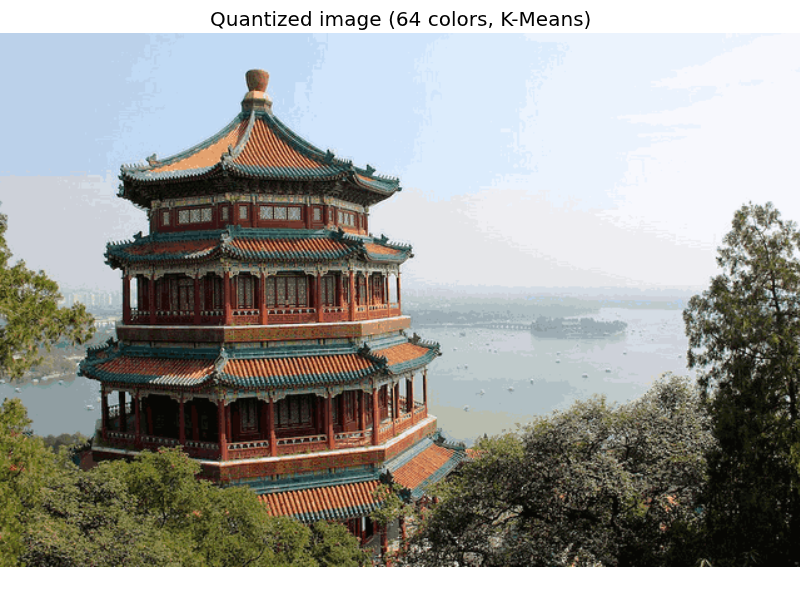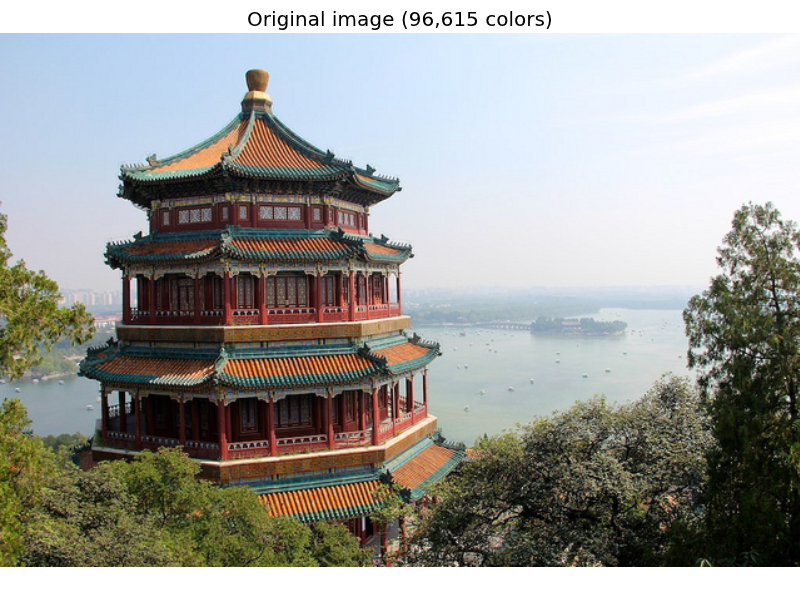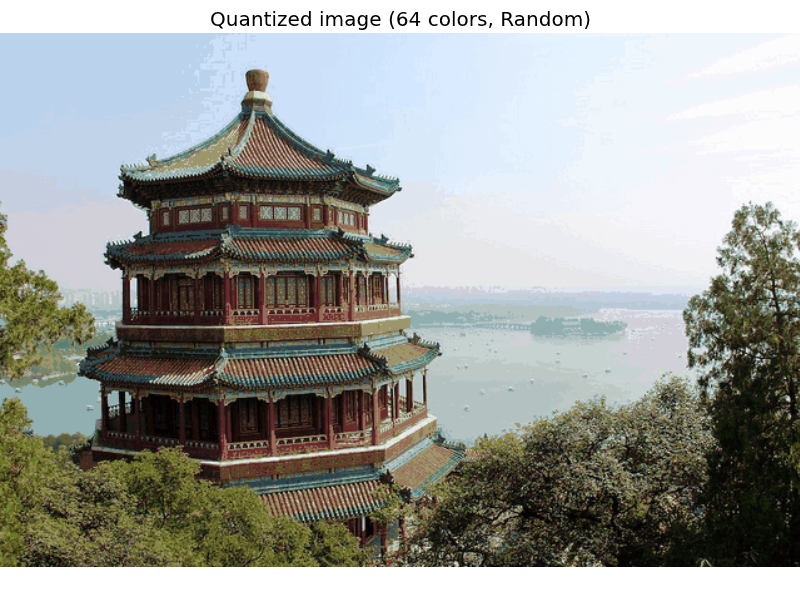Color Quantization using K-Means¶
Performs a pixel-wise Vector Quantization (VQ) of an image of the summer palace (China), reducing the number of colors required to show the image from 96,615 unique colors to 64, while preserving the overall appearance quality.
In this example, pixels are represented in a 3D-space and K-means is used to find 64 color clusters. In the image processing literature, the codebook obtained from K-means (the cluster centers) is called the color palette. Using a single byte, up to 256 colors can be addressed, whereas an RGB encoding requires 3 bytes per pixel. The GIF file format, for example, uses such a palette.
For comparison, a quantized image using a random codebook (colors picked up randomly) is also shown.
Script output:
Fitting estimator on a small sub-sample of the data
done in 0.925s.
Predicting color indices on the full image (k-means)
done in 0.804s.
Predicting color indices on the full image (random)
done in 0.906s.
Python source code: plot_color_quantization.py
# Authors: Robert Layton <robertlayton@gmail.com>
# Olivier Grisel <olivier.grisel@ensta.org>
# Mathieu Blondel <mathieu@mblondel.org>
#
# License: BSD
print __doc__
import numpy as np
import pylab as pl
from sklearn.cluster import KMeans
from sklearn.metrics import euclidean_distances
from sklearn.datasets import load_sample_image
from sklearn.utils import shuffle
from time import time
n_colors = 64
# Load the Summer Palace photo
china = load_sample_image("china.jpg")
# Convert to floats instead of the default 8 bits integer coding. Dividing by
# 255 is important so that pl.imshow behaves works well on foat data (need to
# be in the range [0-1]
china = np.array(china, dtype=np.float64) / 255
# Load Image and transform to a 2D numpy array.
w, h, d = original_shape = tuple(china.shape)
assert d == 3
image_array = np.reshape(china, (w * h, d))
print "Fitting estimator on a small sub-sample of the data"
t0 = time()
image_array_sample = shuffle(image_array, random_state=0)[:1000]
kmeans = KMeans(k=n_colors, random_state=0).fit(image_array_sample)
print "done in %0.3fs." % (time() - t0)
# Get labels for all points
print "Predicting color indices on the full image (k-means)"
t0 = time()
labels = kmeans.predict(image_array)
print "done in %0.3fs." % (time() - t0)
codebook_random = shuffle(image_array, random_state=0)[:n_colors + 1]
print "Predicting color indices on the full image (random)"
t0 = time()
dist = euclidean_distances(codebook_random, image_array, squared=True)
labels_random = dist.argmin(axis=0)
print "done in %0.3fs." % (time() - t0)
def recreate_image(codebook, labels, w, h):
"""Recreate the (compressed) image from the code book & labels"""
d = codebook.shape[1]
image = np.zeros((w, h, d))
label_idx = 0
for i in range(w):
for j in range(h):
image[i][j] = codebook[labels[label_idx]]
label_idx += 1
return image
# Display all results, alongside original image
pl.figure(1)
pl.clf()
ax = pl.axes([0, 0, 1, 1])
pl.axis('off')
pl.title('Original image (96,615 colors)')
pl.imshow(china)
pl.figure(2)
pl.clf()
ax = pl.axes([0, 0, 1, 1])
pl.axis('off')
pl.title('Quantized image (64 colors, K-Means)')
pl.imshow(recreate_image(kmeans.cluster_centers_, labels, w, h))
pl.figure(3)
pl.clf()
ax = pl.axes([0, 0, 1, 1])
pl.axis('off')
pl.title('Quantized image (64 colors, Random)')
pl.imshow(recreate_image(codebook_random, labels_random, w, h))
pl.show()



